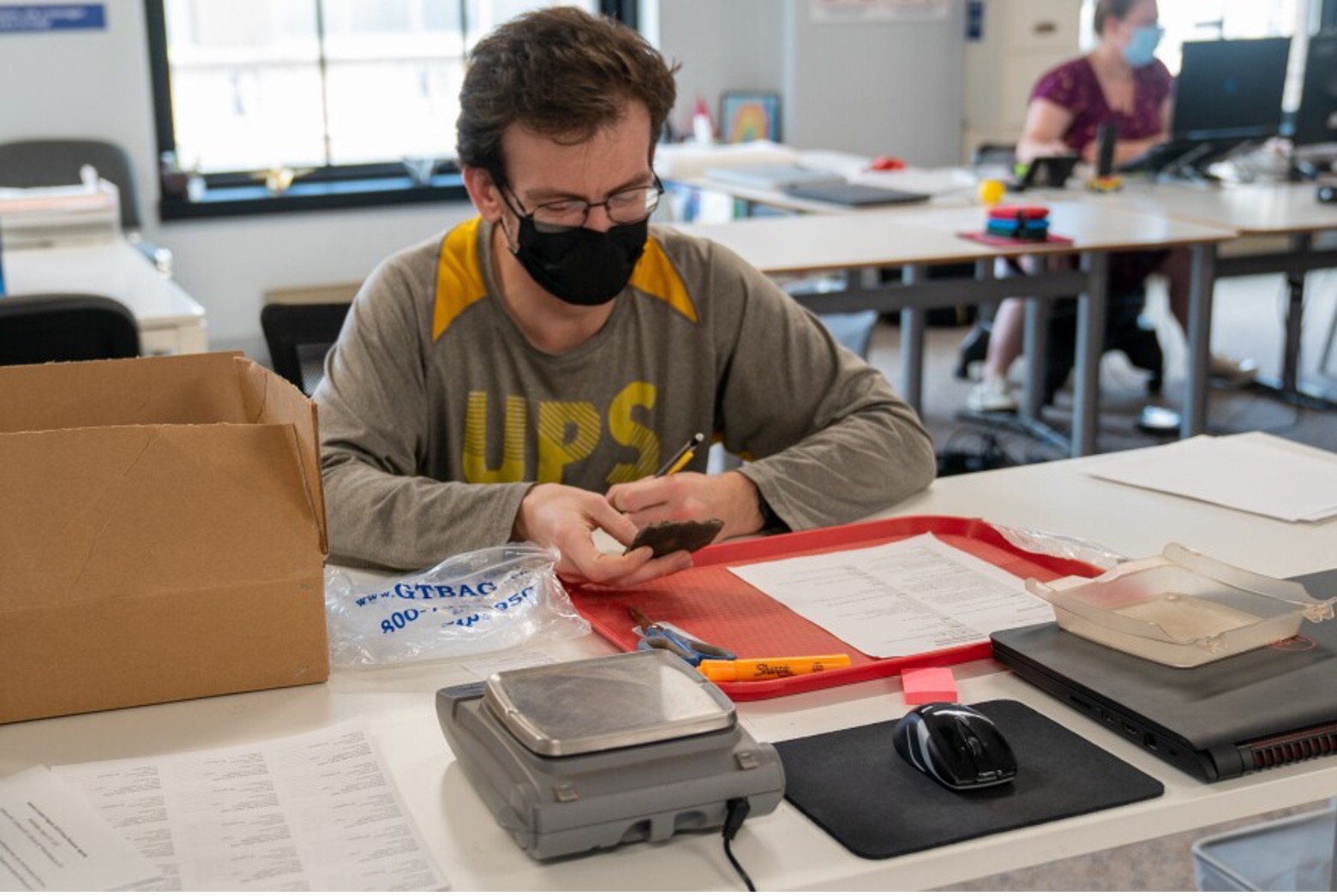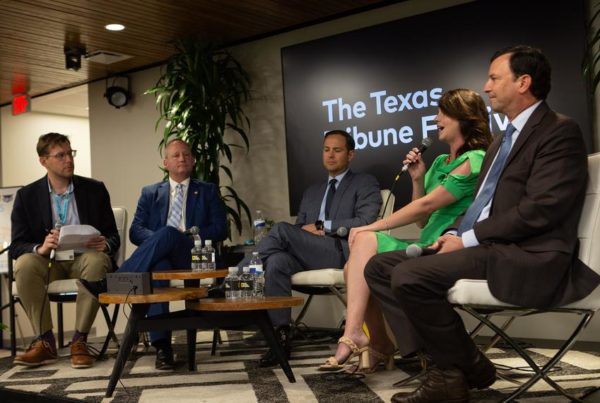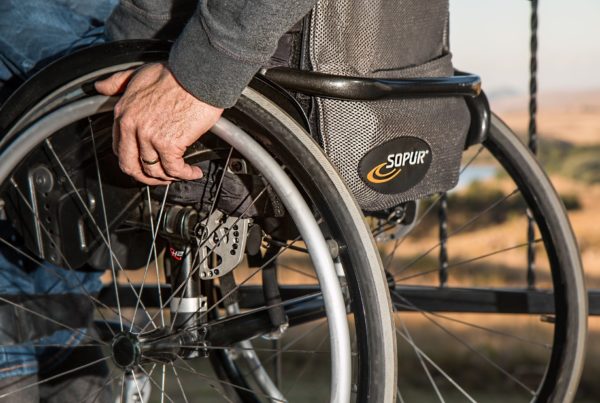If you found the reporting above valuable, please consider making a donation to support it here. Your gift helps pay for everything you find on texasstandard.org and KUT.org. Thanks for donating today.
From The American Homefront Project:
Lab technician Richard Schmitt is hard at work, methodically cleaning a set of 35-year-old field notes from an Army Corps of Engineers project on a river in Pennsylvania. The Navy veteran switches from a sponge to an eraser to rub away the lingering adhesive from a strip protecting the document’s hole punches.
“You can kind of see it. It’s just sticky,” he chuckles. “It could potentially be acidic to the rest of the document.”
Elsewhere in the office in downtown St. Louis, other veterans rummage through boxes filled with artifacts the Corps needs to document and maintain.
“I’ve seen a lot of unique artifacts,” said fellow Army vet and lab technician Chris Miller. “A lot of what people would call rocks — a lot of rocks.”
Schmitt, Miller, and other former service members are part of the Army Corps of Engineers Veterans Curation Program, which hires them for short term jobs. They work with archives, artifacts, and – sometimes – rare objects like arrowheads and pottery remains. Each object needs to be weighed, labeled, photographed, and cataloged in a database before being returned to safe keeping.
It’s a vital part of what the Corps does, even if it’s not as well known as their locks, dams and levees, said Sharon Knobbe, an anthropologist with the Corps’ St. Louis District.
“Anytime we find artifacts in the ground, we are obligated to curate them,” she said. “We really do think of ourselves as stewards of these objects. They tell the history of our nation.”
The Corps has a lot to maintain: more than 50,000 cubic feet of records and artifacts, Knobbe said. That’s enough material to completely fill about 21 shipping containers.
With so much to keep track of, the Corps developed the Veterans Curation Program, which Knobbe manages.
“It’s kind of a two-fold deal,” she said. “We want to provide job skills for veterans, while they rehabilitate these at-risk Army Corps of Engineers collections.”
Twice a year, the program brings a new crop of vets to the St. Louis office for a five month stint. Corps locations in Alexandria, Virginia; Augusta, Georgia; and San Mateo, California have similar permanent programs, while the program has temporary locations in Fayetteville, Arkansas and San Marcos, Texas.
The direct work with archives and historical objects is what attracted Matthew Hanks, who served as a Marine Corps combat engineer for four years.
“If I see something that’s historical, and it’s preserved really well, that just makes me happy,” he said. “It means someone took the time rather than just let it waste away.”
Hanks said preservation has always fulfilled him, even from a young age.
“I would catalog all of my games and books and keep them in this nice box when I wasn’t using them,” he said. “I would always check to make sure the disk, the cartridges were clean before putting them back.”
After his time with the Corps, Hanks plans to return to Southern Illinois University Edwardsville for a Master’s in history and certification in museum studies. He said he’d like to work in a museum in the Pacific Northwest.
But the program isn’t just for veterans like Hanks who want to make a career out of curation work.
“There are other jobs outside of this that deal with archives, collections of some sort, paperwork,” Miller said. “Coming from an infantry background, I never thought this was possible for a grunt basically. It’s not what we were taught.”
Miller served 10 years in the Army infantry, including three deployments to Iraq and one to South Korea. More recently he’s worked as a truck driver and on river barges, but said his body can’t handle those roles anymore.
In the lab, Miller does less physical work and gets coached on things like cover letters and resumes, he said.
“Before this, I never dealt with a resume or anything,” he said. “I’ve always been in high turnover jobs, so you just go in, apply, and start working.”
The dedicated time for career or educational goals has also been vital for Schmitt, who served six years as a boatswain’s mate in the Navy.
“When I got out, I was just in California,” he said. “I was more focused on finding what I was passionate about, which is a good thing, but I wasn’t focused on a long-term plan.”
The program’s short five month length – and the effort its managers make to keep track of each lab technician’s job applications – help him stay focused on his goals, Schmitt said.
“It’s a constant reminder of what I’m working on,” Schmitt said. “If I don’t have anything to show on the tracker, then I know I need to put in a little extra time.”
Finding success
Since the Veterans Curation Program started in 2009, Knobbe said it’s employed more than 700 lab technicians, and more than 90 percent of them have gone onto full-time careers or further education.
“Sorting rocks and doing data entry, it seems it wouldn’t be important for building your job skills,” she said. “I think it lays that foundation.”
Kimberly Blanke is one example. She was a combat engineer in the Marine Corps Reserves before her stint as a lab technician about six years ago. Blanke now manages photography for the program in St. Louis.
“I know what it’s like to spin your tires and not know what you’re doing, and you need someone to help direct and put you on the right path,” she said. “That is really important for me to be able to give back to people that I’ve been in their shoes.”
And the support isn’t fleeting, even if the current lab technicians finish their time with the Army Corps in a matter of weeks, Knobbe said.
“You don’t simply just graduate,” she said. “We stick with people after the program.”














